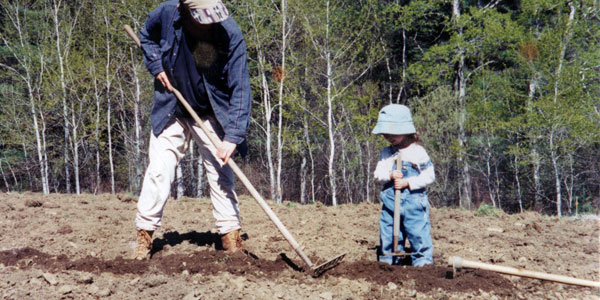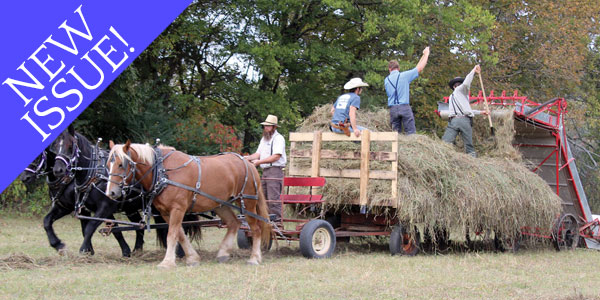
The Work of Rocks
The Work of Rocks
by Reid Bryant of Athol, MA
“The work of rocks, like the work of farmers, is never done.”
Sentinel Elm Farm sits atop a finger of land that disappears in the tannic waters of the Miller’s River. Every year in spring, I pick rocks from the northernmost and highest of the Farm’s open fields, rocks that have been heaved to the surface by winter’s freeze and thaw. The rocks are gathered in white buckets and dumped unceremoniously on a stone wall that borders the fields southern edge. Long forgotten is the Puritan artistry of creation, and the wall, in its fourth century, is collapsing into an undefined heap. But this heap has grown faintly larger with each passing year, denoting my toil, and it is something wonderful to look upon, this freshly picked field. When I squint my eyes, the carpet of bare earth looks soft and new, and clean in the way only dirt can look.
Hundreds of years ago, this was not a field at all, but a hemlock grove, the massive trees casting a church-like silence in the shadows of the ridge top. Forebears of the deer that track the soil on April nights crept silently under those massive branches, freezing at the thump of Nipmuk footfalls on the moist, forgiving needles. It was a different world then, a world without stone walls, with a legacy built of legend and the accumulated litter of fallen leaves. But ox-carts came, and sharp axes, and stone walls to describe the conviction of white farmers. And in their infancy, these walls were simply boundaries, crying out the permanence of fields and families and the presence of man, as if the massive roots of the fallen hemlocks were not irrefutable enough. The walls continued to grow, and the ruins of the hemlocks continued to decay beneath the tilled ground, turning memories of what came before into soil and dust.
“Something there is that doesn’t love a wall” wrote Robert Frost, a man who, like Robert Young, understood rocks and memories. I tend to agree with Frost on principle, not only because he loved the places I love, but also because he pondered the value of stone walls. At the end of a day of picking stones and “mending wall,” my fingers are gritty and raw, and tiny grains of flesh are embedded in the surface of each rock that I’ve handled. So too is a suggestion of me etched into the rocks that I placed last year, and the year before, and the year before that, suspended in the almanac of piled stones. I am compelled, at the end of a day, to pull that wall down in a place, to dig for the bottom and hold in my hand a rock placed lifetimes ago. The poet in me wants to touch that rock, and think on the last human hand to touch it, standing in the self-same place, under the self-same sun, some four hundred years ago. What could it mean for my fingers to touch the grain of an ancestor’s skin, caught in the surface of the granite? Could this touch bring me solace, teach me of passage and of legacy? Perhaps; but the farmer in me is appalled at the idea of undoing work just done, so I glance at the clean brown carpet of soil and turn to walk back down the hill, away from the setting sun.
These stones, their presence and permanence, are silent and patient witnesses to my inconsequence. At a bend in the river behind my motherin- law’s house, a massive outcropping of rock blooms from the gravel riverbed. The rock, known locally as “Gray Rock,” is more of an island than anything, its placement splitting the river in two. In August I lie on the edge of the rock where it juts into the shadow of bankside branches. The afternoon sun dances across the overhang on which I lay, belly down watching the trout that hover in the darkness of the undercut. I have done this for years, just laying and watching. Occasionally, if I remember, I reach into a pocket of garden loam and toss a wriggling worm into the swell of current. It’s a game that I never tire of, watching the trout passively inhale the worm in its descending journey past. I suppose that my body is slowly, automatically, cleaving its way into the surface of Gray Rock, every breath turning more of it to sand. And I wonder if, in the future, some other boy, watching his own trout, will wonder absently at the way in which the contours of the rock accept his chest and belly. Maybe there will be no contour, no boy or garden worms, no trout in fact, in that future world. But I would guess there will be a rock, and a river flowing around it.
I never collected rocks, but I knew plenty of children who did, and I wonder where those collections are now. I wonder if they lie arranged in cardboard boxes, tuck under beds, patiently waiting to be returned to the ground. Stones are confident in that way, in a way I am not; they know where they came from, and they know where they are headed. There is no end for them, just a slow, steady smoothing of rough edges, a mellowing by age and time.
I wonder if the stones in a child’s bedside collection have ever been treasured by a child long since gone, or ever will be again. It seems inevitable, somehow, that stones will be treasured, discarded, and treasured again, tumbling through time in the hands and imaginations of children. It is eternal, this record of stones, and deeply private. But the stones know, and maybe that’s enough.
In a vegetable patch near the Canadian border, Robert Young and his granddaughter are picking rocks. Snow lingers in the shade of the deeper woods; the tilled earth is brown and fresh and clean. The look of the soil pleases them both.
Kim bends to her work, like every farmer before her, in the confidence that the garden will soon be clear of rocks.
A man of epic patience, Robert Young looks up at his granddaughter and smiles. “Uh-huh,” he sighs, a silver threat of saliva stretched between his lips. “I guess the glaciers have only gone away to bring us some more rocks.”




